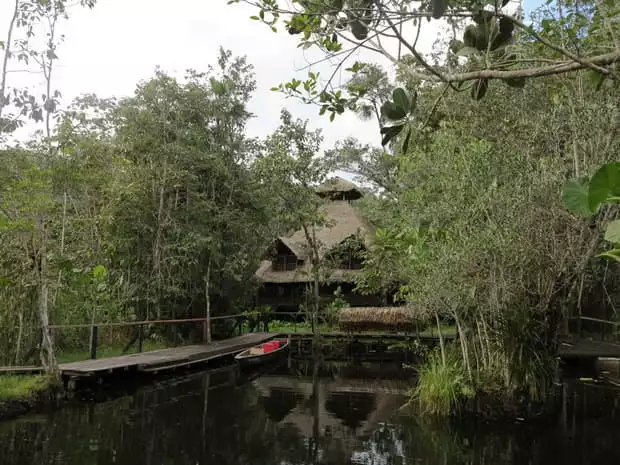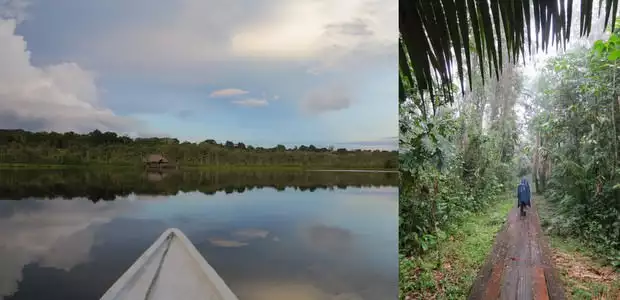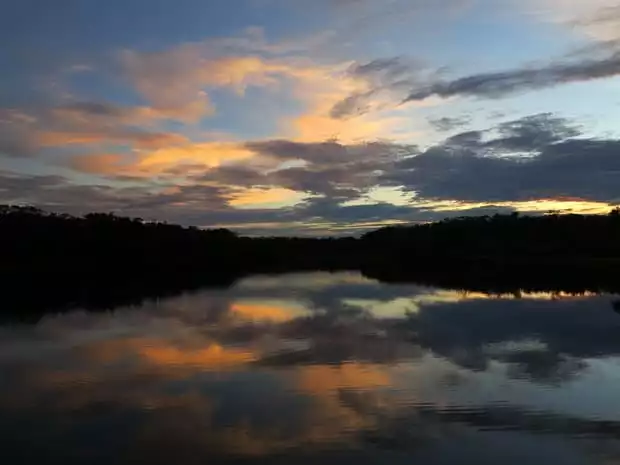AdventureSmith Explorations’ Aaron Gaines reviews his Ecuador Amazon Adventure at Sacha Jungle Lodge.

To actually visit a legendary and mythologized place such as the Amazon rainforest is a heady experience. One is confronted head-on with the reality of this jungle: the unimaginable diversity of plant and animal life, the intense humidity and moisture and rich mud, the loudness of the collective jungle animal community, the sense of mystery and possibility around every corner, the colors, the midday heat. The reality of the place is a confirmation of the myths with the addition of fascinating nuances that one could not expect.
Starting from the Ecuadorian capital city of Quito high in the Andes, a 30-minute jet flight lands me in the small frontier town of San Francisco de Orellana (known as Coca) on the Napo River. This town was the launching site of the eponymous explorer’s successful mission to reach the Amazon River in 1542, and it is now the launching point for visitors to reach the handful of eco-lodges located to the east along the Napo River.
My destination is Sacha Lodge, a 26-room compound located across the river from the northern boundary of Yasuni National Park. To reach it, I embark in a motorized canoe for a two-hour cruise down the muddy river. Along the way I watch the forested banks of the river and see native families fishing and washing clothes, several petroleum camps and a few small native farms. After landing at the Sacha dock, my naturalist guide leads me along a boardwalk for about 30 minutes through the forest. Amidst a heavy rainstorm, I am introduced to the lush greenery of the jungle. All around me the muddy ground is covered in tree litter: fruit, leaves and husks in sizes and shapes I’ve never seen before. There are school-bus-sized palm fronds, several large species of Birds-of-Paradise, thick hanging vines and plants growing on other plants. The cacophony emerging from the forest is like a rainforest meditation soundtrack on steroids. The buzzing and screeching animals, combined with the rain sounds, make the place downright noisy.

The boardwalk ends at a thatched hut housing several long canoes, and a narrow canal begins on the other side. We paddle the quiet canal for a few minutes until we reach the blackwater El Pilche lagoon. Sacha Lodge waits on the far side. There, a series of boardwalks connects several thatch-roof structures. The design of the place – elevated on stilts above the swampy lagoon and spread cleverly into the thickening forest – makes it seem more a part of the landscape than an intrusion upon it. The main lodge hosts a dining room, sitting areas and a treehouse lookout at the top. The guest cabins are dispersed through the jungle and connected with elevated boardwalks. My cabin is a pleasant wooden structure with tall ceilings and a back ‘wall’ consisting of floor-to-ceiling netting, making the jungle immediately beyond the cabin feel like part of the room. This is a nicely-staged trick, as a visitor wants to feel close to the jungle during their stay without worrying about hairy spiders in their beds. An outdoor deck holds 2 cloth hammocks and 2 chairs. The large bathroom is tiled in stone and has a screened back wall as well. This is a great setting for a shower, unless you mind tree frogs and toucans watching as you bathe. The beds are wonderful and, along with the hum of the night forest, invite restful sleep.
This is a great setting for a shower, unless you mind tree frogs and toucans watching as you bathe.
Each day begins with a 5:30am knock on the cabin door: early, yes, but it’s easy to get out of bed when a day of forest exploration awaits me. The cool morning temperatures signal prime bird-watching. One day we walk in the forest quietly before reaching a series of three metal towers connected by a canopy-crossing footbridge. Climbing the tower places us 120 feet above the ground and in perfect position for bird-watching. Using our eyes and a powerful scope, our guide helps us to spot dozens of exotic birds. I am thrilled to spot a family of brownish-orange Howler monkeys resting in the tallest branches of one tree. A baby clings to his mother’s back while a playful juvenile leaps around them. As far as the eye can see is the uninterrupted jungle canopy.

As our small group walks the thin dirt trails, our naturalist guide, Klinger, educates us on topics such as medicinal plants and points out hard-to-spot animals like a family of vampire bats sleeping in the buttresses of a large fig tree. Stunning Blue Morpho butterflies flutter by. Sometimes rain falls, creating a low rumble from the gentle patter of millions of droplets cascading down to the canopy to the understory tree leaves and finally to the ground. Heading back to the lodge one morning, we pause for a few minutes to visit the lodge’s butterfly farm, which is a tent-like enclosure made of cheesecloth. Inside, once you look past the beating wings of hundreds of butterflies, is a garden atmosphere where numerous species are housed. Workers busily prune plants as we allow the colorful bugs to land on our heads, t-shirts and arms. A fellow guest points out a mother tarantula in her nest between two palm leaves, surrounded by dozens of baby tarantulas.


In the afternoons Klinger takes us on long canoe paddles through narrow channels in the flooded forest. We pause frequently to simply enjoy the sounds and smells of the place and to allow our eyes time to scan the thick and complex greenery, looking for the animals it surely contains. Once, we stop after about an hour’s travel and walk for a few minutes, reaching an old Kapok tree that towers above the forest canopy. Around it is wooden scaffolding, which we climb to the top, 40 meters above the ground. There among the top branches of the massive tree we have long views of the rainforest. On the tree’s outstretched limbs grow numerous epiphytes, which are plants that grow on other plants rather than on the ground. On another paddle, we search lucklessly for Anaconda and then stop to observe dozens of squirrel monkeys as they leap across the large palm fronds like frogs across lily-pads. These small, fast monkeys are very difficult to photograph, leaving me with no choice but to watch and enjoy their frenetic journey overhead.

One evening well after sunset, we don headlamps for a nighttime walk through the jungle. Night is when reptiles are active, and as they make up about 80 percent of the wildlife in the Amazon, this is in many ways the best time to go out searching for creatures. Our group of three used our headlamps to spot hairy tarantulas, snakes, huge grasshoppers, various types of exotic spiders, colorful moths and frogs. We saw thick centipedes longer than a human finger, caterpillars, millipedes and nasty Bullet ants. All the while I kept repeating the thought, “I can’t believe I’m doing this.” One of my traveling companions, Brigitte, just about lost her marbles when a cicada (harmless) landed on her shoulder. Though I had reservations about taking this nighttime walk at first, it turned out to be one of the highlights of the trip for me.
All the while I kept repeating the thought, “I can’t believe I’m doing this.”
On Sunday night we had a grand barbeque out on the deck overlooking the lagoon. “Feast” would be the best word to describe the work produced by the chef whose colleagues referred to him affectionately as El Gordo (never trust a skinny cook). It was a beautiful starry Amazon night, and after dinner we used flashlights to spy several caiman cruising around the lagoon. Several of the native staff, imitating the call of the caiman juveniles, aroused one 4-meter alpha male into a display of dominance: he jumped partway out of the water, emitted a loud reptilian roar, and splashed down. The physical power the animal possessed was alarming, and the natives among us declined to make any further sounds.

Sacha Lodge is not just a place; it is a collection of 65 caring local staff and Ecuadorian naturalists. Out there in the jungle, where all supplies, food, building materials, fuel and garbage comes and goes by foot, the wonderful staff and guides work very hard to provide a relaxing, fun, and safe environment for learning and exploration. I was most impressed with the very high quality of the food prepared by the chef, especially the soups. Housekeeping was prompt and thorough, and the hotel manager was ever-present and eager to help with any request. I took advantage of their laundry services for drying several pieces of clothing and footwear, for example. With workers always buzzing about, it is evident to any guest that maintaining a lodge in such a humid and muddy tropical setting must be a real challenge. The place operates like clockwork.
After a few peaceful days in the jungle it can be a bit jarring to leave, particularly when the cities, Coca and Quito, are so easily reached. Mere hours after canoeing across glassy El Pilche lagoon to leave I was driving through bustling Quito to continue on my travels.
This trip is a fantastic complement to a Galapagos small ship cruise. The logistics are straightforward and the travel times short: it is remarkable that a very small country like Ecuador – the size of the American state of Colorado – hosts such diverse wonders as the Galapagos and the Amazon (not to mention the Andes and the sun-drenched Pacific coast). AdventureSmith Explorations can arrange your own Amazon adventure to Sacha Lodge or one of the other respected eco-lodges in this area of Ecuador.
This Ecuador Amazon travel review was written by an AdventureSmith Explorations crew member. Read all AdventureSmith Expert Reviews for more trip reports, or contact one of our Adventure Specialists to learn more about these small ship cruises and wilderness adventures: 1-800-728-2875.
Comments will be moderated and will appear after they have been approved.